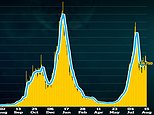Covid deaths rise 56% in a week from 39 to 61
Covid cases FALL: Infections slide 2% in a week to 26,750 as number of deaths rise from 39 to 61 in last 24 hours
Department of Health bosses reported a further 26,750 Covid cases today Deaths have risen sharply, with 61 reported today compared to 39 on August 8No10’s top scientific advisers claimed England’s R rate has dipped below one
<!–
<!–
<!–<!–
<!–
(function (src, d, tag){
var s = d.createElement(tag), prev = d.getElementsByTagName(tag)[0];
s.src = src;
prev.parentNode.insertBefore(s, prev);
}(“https://www.dailymail.co.uk/static/gunther/1.17.0/async_bundle–.js”, document, “script”));
<!–
DM.loadCSS(“https://www.dailymail.co.uk/static/gunther/gunther-2159/video_bundle–.css”);
<!–
Covid infections have fallen by two per cent in a week as Department of Health bosses reported a further 26,750 infections today, a drop from the 27,429 reported last Sunday.
But deaths have risen sharply, with 61 reported today compared to 39 on August 8 – a rise of 56%.
Today’s death toll is down from the 93 reported yesterday, and the 100 on Friday.
Government figures reveal that a total of 154,202 have died with Covid-19 on the death certificate, while 130,953 died within 28 days of a positive test.
But the vaccine effort continues across Britain, with more than three quarters of the adult population double-jabbed against the virus. Just under 90% have received their first dose of the vaccine, and 76.7% have had two.
The figures come as No10’s top scientific advisers claimed England’s R rate has dipped below one for the first time in three months.
The UK Health Security Agency estimates the reproduction rate, which reflects how quickly the virus is spreading, is between 0.8 and 1.0. Last week’s figure was thought to be as high as 1.1.
But it is a lagging indicator and reflects the situation the country faced three weeks ago, when Covid cases began to shrink naturally. Since then, however, the outbreak has started to tick upwards once again, which some experts have blamed on the delayed effects of ‘Freedom Day’.
This week the Office for National Statistics, which carries out tens of thousands of random swab tests, said one in 75 people were carrying the virus on any given day in the seven-day spell ending August 6.
This was the equivalent of 726,700 people and was up slightly on the week before, suggesting the dip in infections seen throughout the end of July was only a temporary blip.
While the proportion of people testing positive in England ‘continued to be high’ at around 1.32 per cent, the ONS estimates suggest an ‘overall decreasing trend over the past two weeks’.
Public Health England officials warned those attending events to arrive early or late to avoid big crowds and wear a mask in crowded places.
UKHSA’s estimate of the R rate suggested the figure may be as low as 0.8 in every region of the country.
But it may still be above one in the East of England and the South West, according to the weekly update.
If the figure — the average amount of people every infected patient passes the virus on to — is below one, it means infections are shrinking.
The R rate is, however, a lagging indicator and does not reflect the situation currently because it is based on a wide mix of data, including deaths – which reflect how quickly the virus was spreading weeks before.
Ministers once put the R rate at the heart of their Covid battle plan.
But it is now less crucial because scientists care more about both hospitalisation and death rates, given the country’s massively successful vaccination roll-out.
Meanwhile, the gold-standard ONS data – which is used by ministers to track the state of the outbreak – showed infection levels in England had started to level off again.
Covid was most prevalent in Northern Ireland, with one in 55 people (1.88 per cent) infected on any given day last week.
Scotland saw a drop in people testing positive, with one in 190 people having the virus (0.53 per cent).
Infection levels stayed low in Wales, where just one in every 220 people were infected (0.46 per cent). But the ONS statisticians claimed it was unclear whether cases were going up or down.
Within England, prevalence rates fell in the North East, North West, West Midlands and London.
The proportion of people infected with Covid rose the fastest in 16 to 24-year-olds, where 3.2 per cent tested positive up to August 6, compared to 2.5 per cent the week before.
Cases also went up in children aged between 2 and 11, jumping from 1.8 to 2.1 per cent, and in 25 to 34-year-olds, where 1.4 per cent tested positive, compared to 1.3 per cent seven days earlier.
Meanwhile, infection levels plateaued in children aged 12 to 15 (3.4 per cent), and over-35s.
The latest figures come as health secretary Sajid Javid this week said the Government aims to have offered a first dose of the Pfizer or Moderna vaccine to all those aged 16 and 17 by August 23 at walk-in centres across the country.
Kevin Mckeon, 14, receives his first dose of the Covid-19 vaccine from vaccinator Geraldine Flynn at the Citywest vaccination centre in Dublin
Writing in The Mail on Sunday, Mr Javid said the aim is to make sure that the teenagers are getting crucial protection against the virus before they head back to sixth forms or colleges.
He wrote: ‘I am delighted we’re able to take even more steps forward, by reinforcing our collective defences and easing additional restrictions that have governed our daily lives.
‘I didn’t come into Government to put curbs on who people can see and where they can go, and I look forward to the day when people don’t need to see me on TV so often, talking about the pandemic.
‘That is why I’m so glad we’ve been able to ease restrictions over the past few weeks and do so in a way that reflects the huge benefits that the vaccines bring.’
![]()


